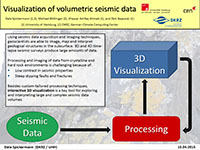Earth’s upper crust is commonly investigated by means of applied geophysics. Seismic methods yield subsurface images for structural interpretation. These subsurface images allow geoscientists to interpret geological units and faults within rock bodies with regard to their structure and temporal evolution. Additional information on elastic subsurface parameters can be obtained with inversion techniques.
Acquisition and processing of 3D seismic data are well-established techniques in the energy and exploration sectors. Especially marine seismic data exploration generates huge data cubes of high-resolution 3D seismic data. Land seismic data is usually of lower quality than marine seismic data. Processing of these data sets is especially challenging when the imaging targets are steep dipping faults in crystalline rock. In such a case, custom-made processing techniques are required.
3D seismics of crystalline rocks: The Institute of Geophysics at the University of Hamburg plays an active part in the processing and visualization of such a data set within the scope of the geothermal project BMWi 0325363C, Seismik im Kristallin. Using this data and the visualization software Avizo Earth, DKRZ created a number of animated visualizations.
 |
The visualization project was presented at the EGU in Vienna on 15.4.2015 as a PICO (Presenting Interactive COntent) presentation: EGU2015-15328: Dela Spickermann, Michael Böttinger, Khawar Ashfaq Ahmed, and Dirk Gajewski: Visualization of volumetric seismic data. A PDF version of the presentation is available here. In order to watch the integrated videos you need to open the PDF file with Adobe Reader – the PDF browser plugin does currently not support videos. File size is 141 MB. |
Literatur: Ahmed, K. A., Schwarz, B. and Gajewski, D. (2015) Application of the 3D common-reflection-surface stack workflow in a crystalline rock environment. Geophysical Prospecting. special hardrock issue (accepted for publication)



